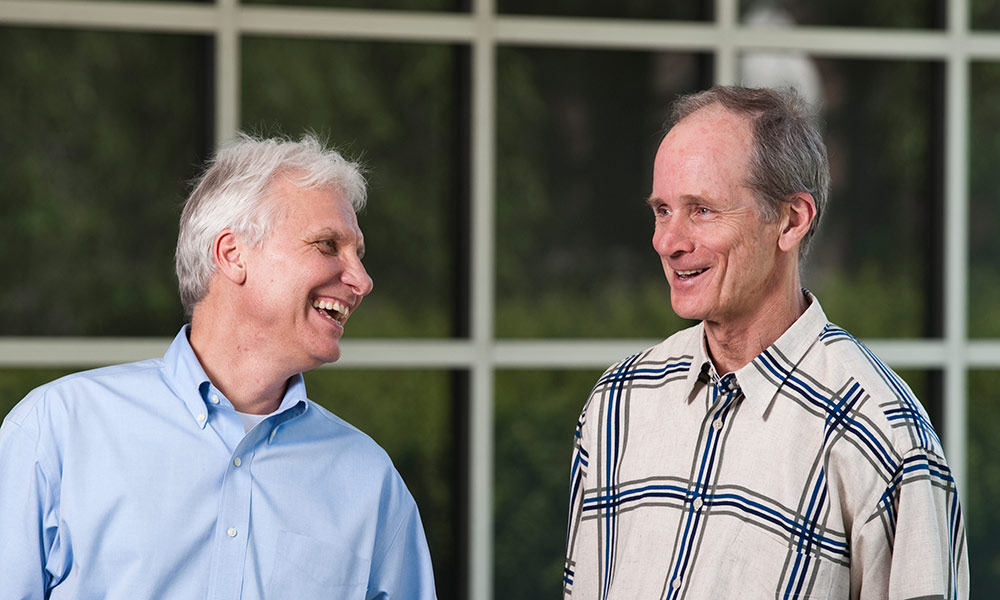It’s a question of carrot or stick. Or possibly neither.
What really motivates us? Humans have pondered this question for decades. Is it money, power, and fame? Or rather fear and punishment? Psychologists’ answers have varied, along with a broad transformation in prevailing views.
“The whole field of motivation has changed over the last 40 years, from thinking about how you can control people from the outside to thinking how you can really facilitate and support people’s commitment and engagement in activities,” says Richard Ryan, a clinical psychologist and professor of clinical and social sciences in psychology at the University of Rochester.
Together with Edward Deci, the University’s Helen F. and Fred H. Gowen Professor in the Social Sciences, the two psychologists are the founders of self-determination theory (SDT) and most recently the authors of the authoritative 700-plus-page volume Self-Determination Theory: Basic Psychological Needs in Motivation, Development, and Wellness (Guilford Press, 2017).
Developed by Ryan and Deci nearly four decades ago, self-determination theory has become one of the most widely accepted theories of human motivation in contemporary behavioral science. Its starting point is the idea that all humans have the natural—or intrinsic—tendency to behave in effective and healthful ways. To date, their research has been cited several hundred-thousands of times, spawning thousands of clinical experiments and studies worldwide.
Central to SDT is the distinction between two types of motivation—autonomous motivation (sometimes also called intrinsic motivation) and controlled motivation. “Autonomous motivation has to do with engaging in an activity with a full sense of willingness and volition,” Deci explains. “Whereas controlled motivation means doing something with the experience of pressure and obligation.”
The evidence-based theory holds that all humans have a basic need for autonomy, competence, and relatedness. In a nutshell: Research by the pair (and inspired by them) suggests that we need to feel that we can succeed at a task and that we are making progress towards that success—what they call competence. Meaningful options as we work toward that competence constitute our autonomy. Lastly, we need to feel that our efforts are recognized by others and that we are part of something beyond ourselves—what Ryan and Deci have termed interpersonal relatedness.
Listen to the full interview with professors Richard Ryan and Edward Deci in an interview hosted by University QuadCast host Sandra Knispel. Deci and Ryan discuss the principles of intrinsic motivation, why money is often a poor incentive, and how neuropsychology is now able to show on MRIs what they have been able to study in experiments for decades.
What’s the enduring pull of the theory for today’s researchers? “I think there’s a lot of control in the world,” says Deci. “There are a lot of people who are trying to push others around—in organizations, in politics, in homes. And a lot of people are paying attention to this other point of view [SDT] because they don’t like the control they find in so many aspects of their lives.”
SDT is more than a theoretical construct. Deci and Ryan, along with independent scientists around the globe and across several sub-specialties, have found many real-life applications for SDT in areas ranging from parenting, to workplace organization, to health care, wellness, sports, education and virtual worlds.
“One of the things that we see in high-quality motivation, no matter the domain, is that people are passionate about what they are doing and they really value it,” explains Ryan. Regardless of whether SDT is applied to employees, patients, students, athletes, or one’s own children, Ryan says, it’s important that people engage whole-heartedly in what they are doing. “It’s that high quality motivation that comes from the inside.”
The two SDT pioneers have studied practical ways in which parents, managers, coaches, and teachers can help or hinder motivation in others in ways that will either improve the person’s effectiveness, engagement, and sense of well-being, or have the opposite effect.
“We want people as agentic as possible,” says Ryan. Add to that the necessary ingredient of autonomy—one of the key points on which SDT pivots and which the duo believes to be a fundamental and universal psychological need— and you’ll have the basic recipe for motivation.
Giving people a good reason to do what they are doing, why it’s valuable or useful, is key to helping the individual take ownership and be excited about what they are doing. “Unfortunately, so often when people try to motivate others they take responsibility rather than helping the person find responsibility themselves,” Ryan describes a frequent pitfall.

Now at the apex of their careers, Deci and Ryan, have not always been titans in their field. When, as young scientists in the late 1970s, they first began to question the behaviorist school of motivation, their theory was greeted by sizable skepticism, sometimes even outright condescension.
“Yes, it was met by a lot of critiques,” Ryan acknowledges. “But I think a lot of the tension in the field was about these anomalies [such as curiosity and exploration] that behaviorism just couldn’t explain.”
For several decades beginning in the 1950s, the behaviorists dominated the study of motivation to the near exclusion of any other theory, with their research focused on how the provision of rewards affects and conditions human behavior. But Ryan and Deci doubted the veracity of the theory. They found the opposite to be true: that rewards such as prizes and money were not only less effective than behavioral psychologists had hitherto believed, but under some circumstances could actually diminish people’s engagement and motivation.
Ryan and Deci’s first book Intrinsic Motivation and Self-Determination in Human Behavior (Springer US, 1985) seemed a Copernican turn in itself, repudiating the dominant theory. Realizing they were on thin ice, both agreed early on to stick to things they could empirically substantiate. “No speculating,” Ryan sums up their early-career rule. Show—don’t tell became their professional mantra.
Their early work helped establish the duo as a team to be reckoned with. In 1969, the young Deci, in search of a PhD thesis and fascinated by what drives motivation, used Soma puzzle cubes, a then popular Parker Brothers game, for a study on the effectiveness of rewards. He found that when money is used as an external reward for a specific activity, the test subjects ultimately lose their intrinsic interest.
In this landmark study, Deci asked two groups of participants to reproduce the requested puzzle combinations as seen in provided images—and watched how they behaved from outside the rooms. On day one both groups performed the task without any external reward. The second day, he offered to pay the participants in one group, based on their success. As expected, the monetary reward delivered a short-lived boost to the group’s attempts at solving the puzzles. But by the next day, the effect had worn off. When Deci announced that he had no more money left to pay, this group was less motivated than the group that had never been paid. Worse, the compensated group paid less attention to the puzzles on day three—than they had on day one of the experiment, before money had been held out as an inducement. Meanwhile, the uncompensated group’s interest in the puzzles actually increased. Deci’s conclusion? Rewards such as cash can actually reduce a person’s longer-term motivation to continue a given project.
At the time, the conclusion was highly controversial, but Deci was off and running. A short time later, he was joined by Ryan, a clinical psychologist who shared these sensibilities about the importance of autonomy in motivation. Together they built a broader and deeper theory, becoming lifelong collaborators.
Later, conflicts arose with cross-cultural theorists, particularly those who argued against universal truths in human motivation, recalls Ryan. He and Deci, along with many other researchers, responded to the critique by testing SDT across many cultural contexts. The results of those studies upheld the core principles of their theory.
But controversy is par for the course, they both agree. Adds Deci: “I have to say that it’s been fun. I mean having controversies, and dialogues, and debates. It’s an aspect of how you proceed with scientific psychology.”
His enthusiasm palpable, Ryan notes that in recent years, neuropsychology has opened up an entirely new window into studying (and substantiating) SDT.
“All types of motivation are reflected in the brain. When people are highly intrinsically motivated there’s a lot of activation in their dopaminergic system, which really means the brain systems that are associated with pleasure and rewards.” When people have their basic psychological needs satisfied and difficult decisions to make, they have more access to the areas of the brain where self-knowledge is located, which is needed for effective decision making, Ryan explains. The new neuropsychological evidence, visible through magnetic resonance imaging, helps psychologists fine tune some of their thinking, making it a “beautiful interface because both can inform each other.”
Does he ever feel vindicated by what MRIs can now show about their theory?
“If there’s any sense of ‘I told you so’—well, there’s always gratification when things turn out to be right,” Ryan smiles. “But I guess we’re pretty much always focused on the things we still have to do and the refinements that still have to be made.”
“I think we’ve believed in what we are doing from the start,” Deci adds. “And we keep at it.”





